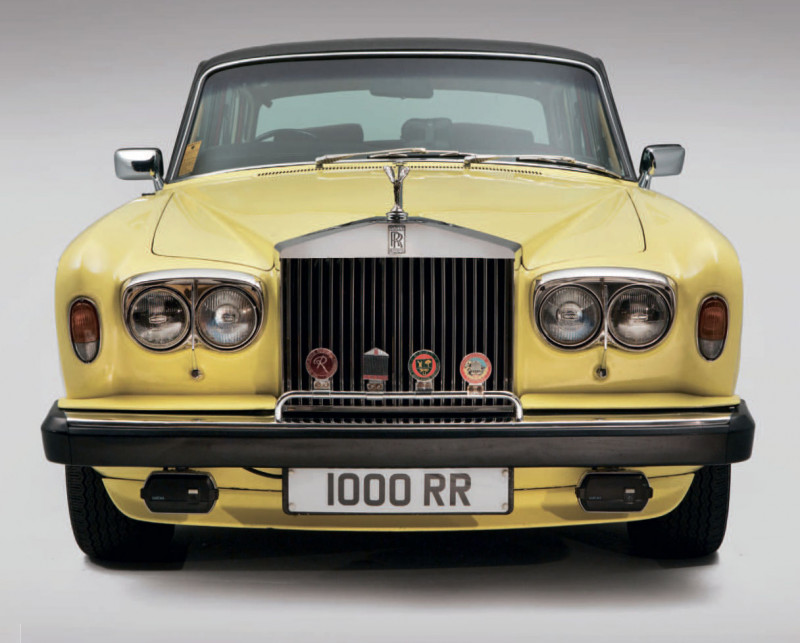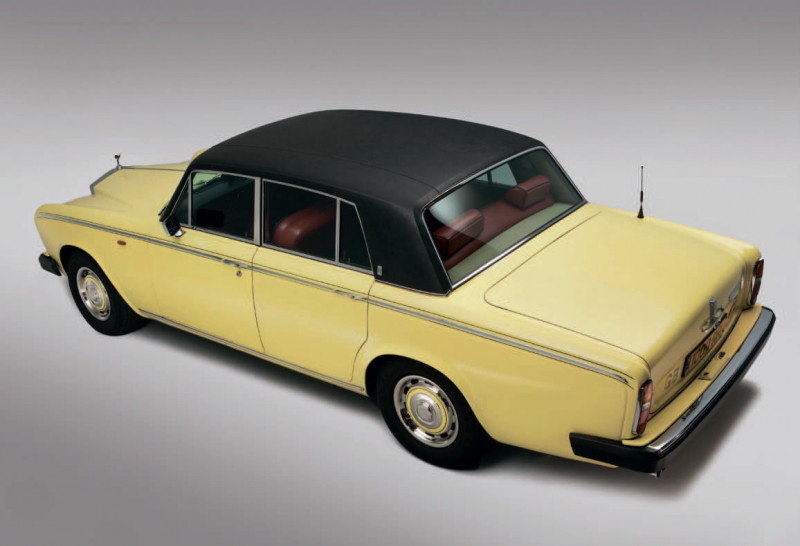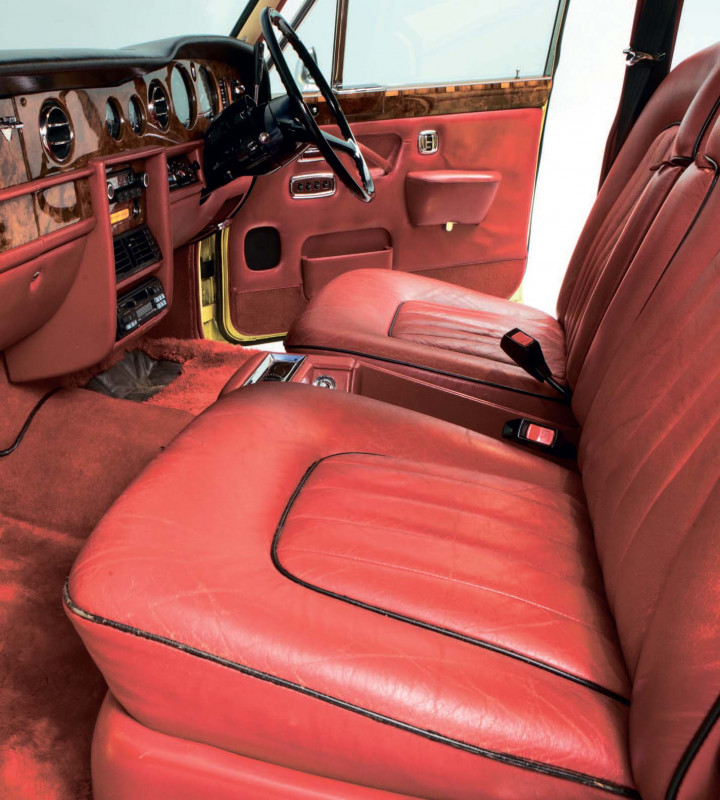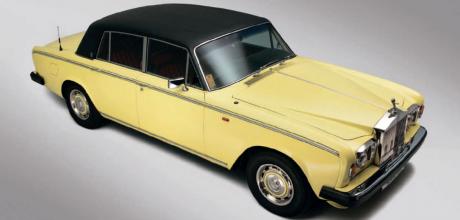Rolls-Royce Silver Shadow
After the Cloud comes the Shadow, but was it the best car in the world?
Words: Gavin Braithwaite-Smith
Pictures: John Colley
SIMPLY THE BEST?Profile: Rolls-Royce Silver Shadow
In building the Silver Shadow, Rolls-Royce achieved what it set out to accomplish when worked started on the project in 1954, before the launch of its predecessor, the Silver Cloud. Unveiled in 1965, the Silver Shadow was probably the best car in the world, in the same way that Carlsberg is probably the best beer in the world. Keep repeating something until it becomes a fact. A combined total of 40,556 of all Silver Shadow and Bentley T-series variants made it the most successful Rolls-Royce ever produced. By the end of October 1965, following appearances at the Paris and London motor shows, Rolls-Royce had received 3000 firm orders, creating an 18-month waiting list for a vehicle described by Autocar as a ‘superlative journey car’.

The Silver Shadow went on a journey of its own, following the end of production in 1980. With supply outstripping demand, high-Roller prices dropped to levels low enough to attract the kind of clientele previously alien to Rolls-Royce. Spotting the Spirit of Ecstasy in places unsuitable for a Flying Lady tarnished the car’s once gilt-edged reputation, as did an association with scrap metal merchants, end-of-the-pier entertainers and ‘diamond geezers who only deal in cash, mate’. Participation in banger races was a sorry (and often sudden) end for cars that took three months to build. Even today, a Silver Shadow could be yours for less than the price of a new Dacia Sandero; the average auction price paid in 2021 was just £13,000. A small price to pay for a former ‘Best Car in the World’. But what made it so special, and did it deserve its title as the world’s best?
In October 1965, Autocar said the Rolls- Royce possessed ‘more individuality and advanced engineering than this company has ever displayed in a new model’. Not only did the Silver Shadow look different to the graceful old dowager, the Silver Cloud, but it also ushered in a new era of manufacturing at the Crewe factory. Out with the old separate chassis and in with a new monocoque construction. A controversial move that upset the Rolls-Royce and Bentley purists, but one that was critical for the company’s long-term survival. The decision can be traced back to February 1954 when the project was given the codename Tibet. It would be developed alongside Siam, the project that would lead to the launch of the Silver Cloud and Bentley S-Series in 1956.

Work began in earnest in 1958, when the project was expanded to include Burma, a proposed smaller and sportier Bentley version. Ultimately the plans were shelved on the grounds of cost, leaving the T-Series to be little more than a badge-engineered Silver Shadow. Just 2585 Bentley versions would be built, with many buyers happy to pay an extremely small premium for the prestige of seeing the Flying Lady perched atop the ornate radiator grille. As a result, the Bentley always felt like the also-ran in the thoroughbred’s race to claim the title of the best car in the world.
Adopting a method of construction commonly associated with mass production didn’t mean building a car for the masses. Neither did it mean the abandonment of the company’s legendary levels of quality and craftsmanship. As Citroën had demonstrated with the Traction Avant, and more latterly the DS, unitary construction delivers packaging and cost benefits without sacrificing quality and innovation. For customers, it meant a vehicle that was 6.75 inches shorter, 3.75 inches narrower and 4.5 inches lower than the Silver Cloud, yet with greater cabin and boot space. For Rolls- Royce, it meant an opportunity to recoup the high costs of research, development, tooling and production over a longer period. The company expected the Silver Shadow to remain on sale for a decade, but the saloon lived on until 1980, while the Corniche and Bentley Continental convertibles based on the same platform, remained in production until 1995. A remarkable innings for a car with its roots in the 1950s.

As the company’s first stylist, John Blatchley, known as the ‘shaper of the modern Rolls-Royce’ (Independent, April 2008), deserves huge credit for the styling of the Silver Shadow. ‘Styling this car was very much an architectural exercise,’ he told Giles Chapman. ‘The specification demanded it be lower, narrower, shorter, with better visibility and luggage space, and a bigger petrol tank. My biggest challenge was getting all this paraphernalia, plus passengers, into a car that still looked right.’
Rolls-Royce enlisted the help of Citroën for the Silver Shadow’s most innovative feature. Hydraulic suspension was viewed as a necessity, not only to cope with the car’s size and weight, but also to satisfy the American market. Having experimented with a compressed air system that required pumping up every month, it turned to Citroën for inspiration, dismantling a DS19 to learn about the French firm’s hydropneumatic suspension. Realising it couldn’t build something to Citroën’s standards, it licensed the high-pressure accumulators and pressure regulating valves for use in the Silver Shadow. The two aren’t the same. Whereas the system in the Citroën DS was totally hydraulic, in the Silver Shadow it merely kept the car at a specific level and was supplementary to a conventional coil spring system.
Hydraulics also controlled the four-wheel disc braking system, but while a disc on each corner was a step forward for Rolls-Royce, it was one of the last manufacturers to adopt this feature. Other innovations included independent rear suspension, recirculating ball steering with power assistance, electric front seats and windows, electric gear selector and built-in air-conditioning (optional until 1969). Air-con was standard in the US from the beginning, with a Rolls-Royce executive quoted by the Wall Street Journal as saying: ‘If you don’t want air-conditioning, you simply don’t turn it on.’ Quite.
The all-aluminium 6230cc V8 engine (tweaked for the Silver Shadow) and GM four-speed Hydramatic transmission, built in Crewe and modified to accept electric actuation, were the only legacies from the Silver Cloud III. Rolls-Royce also introduced the new GM400 TurboHydramatic transmission for left-hand drive cars. Widely considered to be the best available at the time, it became standard equipment on all Silver Shadows in 1968.
You won’t find Rolls-Royce lowering itself by quoting performance and economy figures, but Autocar data from 1967 reveals a top speed of 115mph, a 0-60mph time of 10.9 seconds and fuel economy of 13mpg. Just as significant was the 360 miles per tankful of petrol, with the increase aided by the car’s relative lightness over the Silver Cloud and the 24-gallon tank (up from 18 gallons). Fewer stops for fuel on a cross-continental schlep to the slopes was a bonus for the new breed of Rolls-Royce owner-drivers.
John Bolster, writing for Autosport in 1967, was suitably impressed, saying: ‘The Rolls-Royce Silver Shadow is a car which, by great complexity and elaboration of design, makes driving easier and safer than ever before. It is a wonderfully untiring car for long journeys, and this applies to all the occupants, but above all, it is fun to drive. Having studied all its technical details and admired the superb workmanship, I am at a loss to understand how it can be made for its admittedly high price. No car offers greater value for money.’
The ‘admittedly high price’, give or take a few shillings, was £6669. That’s around £125,000 in today’s money. Or, to put it another way, nearly double the average house price in 1967. Still, the average des res didn’t benefit from the finest Wilton carpets, the most sumptuous lambswool rugs, classic burr walnut finishes and Connolly leather. Standard equipment included electric windows, a choice of three radios, electric aerial, front and rear speakers, three cigar lighters, picnic tables, safety harnesses (seat belts were optional), heated rear window, windscreen washers and remote-control fuel filler cap. Items we take for granted today, but that were almost unheard of in 1965. Four stainless steel exhaust silencers and excellent soundproofing ensured the car’s occupants were cocooned in something akin to an automotive anechoic chamber Bjork would delight in. Shh.
Autocar said the Silver Shadow ‘had a finish to be proud of’, and even praised the Yale door locks ‘after the rubbishy stuff on some other cars’. Rolls-Royce demanded extraordinary care and fastidious attention to detail. It took 12 workers to create the iconic radiator shell using 11 separate items of steel. Only the finest hides were selected for the leather upholstery, using stock grazed in fields without barbed wire for the perfect finish. Even the burr walnut, sourced from Italy, was stored in an old air raid shelter to match the underground conditions of the supplier. The glass-like finish was the result of hours of polishing and lacquering, although 60% of each veneer was discarded during preparation. A further 10% was kept back for future repairs, catalogued with the car’s chassis details and stored in the air raid shelter.
In one of the most objective Silver Shadow reviews of the 1960s, Motor praised its ‘high performance with unrivalled quietness’, but said it was ‘not flawless’.
A single paragraph provides a snapshot of what the magazine considered to be the best-in-class yardsticks at the time. ‘A car with less engine and transmission noise than a big American automatic, for example, is a very quiet car indeed; anyone who succeeds in suppressing road noise better than in a Peugeot 404 or wind noise more effectively than in a Saab is doing well, as is the designer who succeeds in making a big car steer and handle better than a Jensen FF or ride more smoothly on rough roads than a Citroën DS. These are the alpha plus standards by which the Silver Shadow must be assessed.’ Reviewed after a 3000-mile test, Motor found problems with the heating and ventilation system, an inoperative kickdown, a fascia air vent that had jammed open and what it described as ‘noticeable’ road noise. It did concede that this was due to the success of measures designed to supress engine and wind noise. Motor also found fault with rear-end grip on wet roads and the ‘peculiarly chosen’ transmission ratios.
Rolls-Royce was quick to respond to criticism and feedback from owners and journalists alike, with the Silver Shadow subjected to a policy of continuous development. A stiffer front anti-roll bar, new anti-roll bar at the rear (not in North America) and smaller 16-inch wheels were just some of the measures designed to improve the handling.
Rolls-Royce even removed the self-levelling height control from the suspension due to the adverse effect it had on the handling. Air-con was standardised in 1968, followed by central locking in 1970, with radial tyres specified in 1972. Even bigger news was the introduction of the 6750cc V8 engine at the end of 1969, created using a redesigned crankshaft on the existing 6230cc unit. Designed to satisfy American emissions regulations, it had the added benefit of an extra 20bhp, increasing the output to around 220bhp.
There were safety changes, too, like the use of energy-absorbing materials around the dashboard to protect the car’s occupants. The windscreen, centre console and front seat backs were also modified, along with new recessed switches, door latches and grab handles. Also in 1969, a long-wheelbase version was added to the range, complete with division between the front and rear seats. Other variants introduced during the Silver Shadow’s reign included a two-door saloon, Corniche convertible and Silver Wraith, along with their Bentley equivalents.
The Silver Shadow survived the collapse of the aero side of the business in 1971 and appeared to flourish following the creation of Rolls-Royce Motors. Indeed, the Silver Shadow II, introduced in 1977, is acknowledged as being the best of the breed. A comprehensive facelift included new rubber-tipped front and rear bumpers without overriders, a deeper radiator shell, different door handles, the introduction of a front spoiler, spring-back door mirrors, rack-and-pinion steering, revised front suspension geometry, new carburettors, revised instrumentation, a smaller steering wheel, and the split-level air conditioning system from the Camargue. These are in addition to the 2000-odd modifications made to the car in the first nine years, during which time some 20,000 cars had already found a home.
Motor was unequivocal in its praise for the Silver Shadow’s second coming. In conclusion, it said: ‘There are quieter cars, there are quicker cars but none cossets its occupants in quite the same manner, none insulates them from the outside world quite so effectively, to the point where rush-hour traffic jams, inclement weather and the other irritations of day-to-day living no longer seem to matter. Inevitably, there are areas in which the Shadow can be (and is) surpassed by other cars, some of them much cheaper. But there is no other car in the world that combines all its qualities, or that could still be in its prime after 100,000 miles.’ The best car in the world? Probably.
Buy this car!
The fabulous March 1980 Silver Shadow II in the pictures, was bought by the current owners in July 1988. Used for UK events and European rallies, it has 89,709 miles on the clock. Those owners have decided to sell their Shadow and they’re looking for offers of around £35,000, to include the registration. The Rolls-Royce comes with all of the history from their ownership period, with the car maintained by Duane Starman. He’s your point of contact if you’d like to see the car; you can reach him on 01455 292 053.
Shadow values (1965-1980)
Original price to the public, at launch: £6557
Average auction price in 2008**: less than £4000
Average auction price in 2021**: £13,000
**Average international auction prices:
- 2010: €11,169
- 2015: €14,887
- 2020: €13,384
- 2021: €22,467
The celebrity factor plays a big part: the ‘jump’ in global average auction sales between 2020 and 2021 may be due to the Silver Shadow (ex-Princess Margaret) sold in June 2021 for more than €115,600, as well as another celebrity sale, singer Wayne Newton’s Silver Shadow II, at €78,623.
Car & Classic: 1977 Rolls-Royce Silver Shadow II (one of the first to be produced) was recently sold for a ‘down-to-earth’ £8600; the car’s renovation, 25 years ago, was largely cosmetic, involving a re-paint and re-upholstering which turned it into a red model with black leather/red piping from a less sedate gold one. An extremely well-preserved Silver Shadow has just emerged from dry storage: Car & Classic auctions has a 1970 car which has been kept in storage for 35 years; the auction was due to finish just before Christmas.
**Data from Ademy UK (Automotive Data Evaluation Market Yields)


